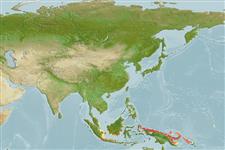>
Eupercaria/misc (Various families in series Eupercaria) >
Sciaenidae (Drums or croakers)
Eponymy: Rev Dr Christoph Samuel John (1747–1813) was a botanist and herpetologist and a medical missionary (1771–1813) at the Danish trading station of Tranquebar (now Tharangambadi), Tamil Nadu, not far from Madras (Chennai). [...] (Ref. 128868), visit book page.
Environment: milieu / Zona climática / intervalo de profundidade / distribution range
Ecologia
marinhas; Água doce; estuarina bentopelágico. Tropical
Western Central Pacific: northern (=Pacific) coasts of New Guinea.
Tamanho / Peso / Idade
Maturidade: Lm ? range ? - ? cm
Max length : 14.0 cm SL macho/indeterminado; (Ref. 9772); common length : 10.0 cm SL macho/indeterminado; (Ref. 9772)
Espinhos dorsais (total) : 11; Raios dorsais (total) : 25 - 29; Espinhos anais: 2; Raios anais : 7. Eye small, 11 to 16 % of head length; snout bluntly rounded; no barbel on chin; teeth differentiated into large and small in both jaws; gill rakers slender, about half the length of gill filaments at angle of arch, 10 to 13 on lower limb. Second anal spine long, stiff, 45 to 54 % of head length. Scales on head and throat cycloid (smooth). Swim bladder hammer-shaped, with about 12 pairs of arborescent appendages along its sides, the first entering head and sending a palmate branch to the front of the pectoral arch. Sagitta (large earstone) with a tadpole-shaped impression, the head of which has its long axis lying obliquely to that of sagitta and the tail expanded and deepened as a hallow cone connected with the head by a narrow groove.
Body shape (shape guide): fusiform / normal.
Inhabits estuaries and rivers (Ref. 9772).
Ciclo de vida ou comportamento de acasalamento
Maturidade | Reprodução | Desova | Ovos | Fecundidade | Larvas
Sasaki, K., 2001. Sciaenidae. Croakers (drums). p.3117-3174. In K.E. Carpenter and V.H. Niem (eds.) FAO species identification guide for fishery purposes. The living marine resources of the Western Central Pacific. Volume 5. Bony fishes part 3 (Menidae to Pomacentridae). Rome, FAO. pp. 2791-3380. (Ref. 9772)
Status na Lista Vermelha da UICN (Ref. 130435: Version 2025-1)
Ameaça para os humanos
Harmless
Uso pelos humanos
Pescarias: sem interesse
Ferramentas
Relatórios especiais
Baixar XML
Fontes da internet
Estimates based on models
Preferred temperature (Ref.
123201): 28.3 - 29, mean 28.8 °C (based on 52 cells).
Índice de diversidade filogenética (Ref.
82804): PD
50 = 0.5000 [Uniqueness, from 0.5 = low to 2.0 = high].
Bayesian length-weight: a=0.00891 (0.00412 - 0.01928), b=3.08 (2.91 - 3.25), in cm total length, based on LWR estimates for this Genus-body shape (Ref.
93245).
Nível Trófico (Ref.
69278): 3.4 ±0.4 se; based on size and trophs of closest relatives
Resiliência (Ref.
120179): Elevada, tempo mínimo de duplicação da população menor que 15 meses (Preliminary K or Fecundity.).
Fishing Vulnerability (Ref.
59153): Low vulnerability (10 of 100).
🛈
